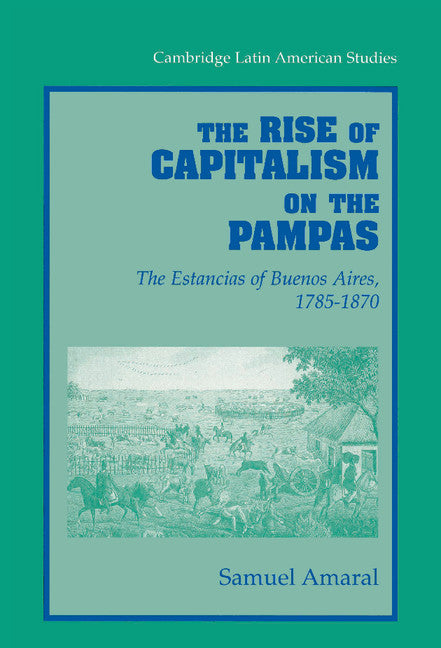Freshly Printed - allow 8 days lead
Couldn't load pickup availability
The Rise of Capitalism on the Pampas
The Estancias of Buenos Aires, 1785–1870
Amaral focuses on the estancia, livestock firms, that led the economic growth of Buenos Aires in the early 1800s.
Samuel Amaral (Author)
9780521572484, Cambridge University Press
Hardback, published 13 July 1998
382 pages, 54 b/w illus. 11 maps 67 tables
23.7 x 16.1 x 2.8 cm, 0.715 kg
'Samuel Amaral is outstanding … he homes in unerringly on the essentials, treating the estancia as an exercise in economic organisation. He gives meticulous accounts and precise measurements of the internal structure, operations and economic aims of estancias, and places then firmly in their political and economic context. He argues that their expansion was due not only to well-known external factors - the growing demand for hides, for example - but also to human analysis and willpower. In one of the most striking and original chapters, finely documented, he shows that management and entrepreneurship, including skills in pricing land, cattle, labour and supplies, were vital in securing good returns from investments. Under Samuel Amaral's guidance we can follow the signposts in the pampas, from peons to profits.' The Times Literary Supplement
In the early decades of the nineteenth century, Buenos Aires underwent rapid economic growth, only dwarfed by the even greater prosperity that occurred there at the end of the century. Previous studies have focused on the economy as a whole, or on a particular segment of the population; and most have disregarded how resources were intentionally organized to enable growth. This book focuses on the estancia - livestock firms, the economic organizations that led the growth process. The internal structure, production conditions, and economic impact of the estancia are the central issues which Amaral considers. Economic growth and increased freedom were not inevitable on the pampas, but rather the consequences of human actions, both deliberate and unintentional, in the search for an elusive profit. Why freedom, not privilege, prevailed is the key question underlying this study.
Preface
1. Introduction
Part I. Estancia: 2. The organization of production
3. Capital structure, 1820–50
4. Model and reality
Part II. Conditions of Production: 5. Reproduction and density
6. Environment
7. Institutions
Part III. Human Action: 8. Labour
9. Management and entrepreneurship
Part IV. Results: 10. Profit
11. Prices and marketing
12. Markets
13. Conclusion
Appendices: A. Profit rate
B. Probate inventories
C. Prices, exchange rates, and trade statistics.
Subject Areas: Modern history to 20th century: c 1700 to c 1900 [HBLL], History of the Americas [HBJK]


